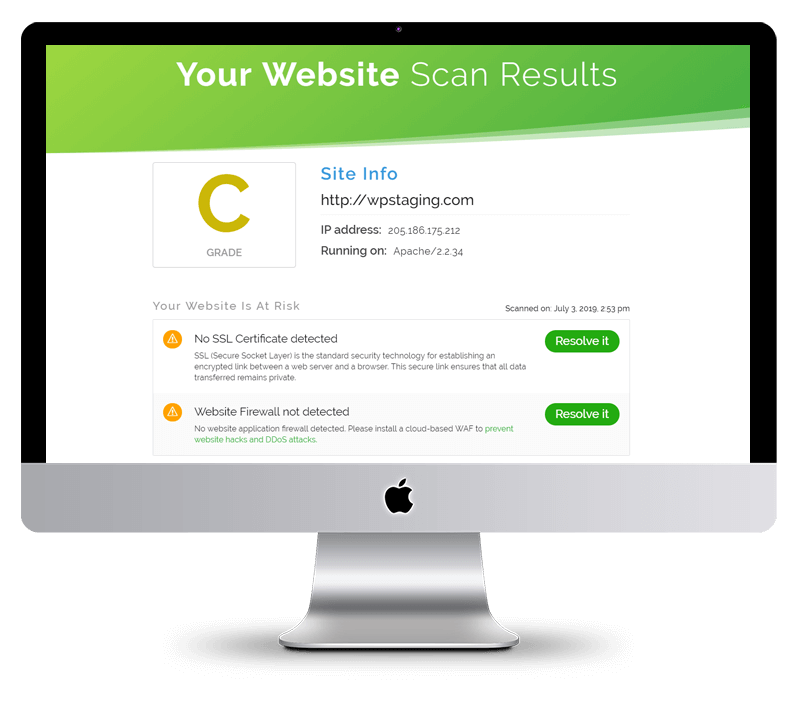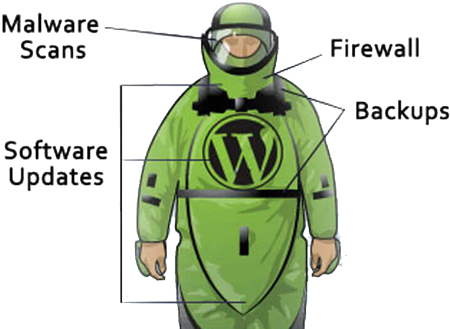FREE WEBSITE SECURITY CHECK TOOL
SCAN YOUR SITE FOR MALWARE AND OTHER SECURITY RISKS

As a website owner, you are responsible for the security of your website and all your user’s personal details it contains.
We created this quick, free website scan to check for common security risks like outdated software.
The scan also checks if your site is currently infected with malware, if it has been blacklisted by any search-engines, and if your server configurations are exposing security vulnerabilities.
Did You Know…
new websites are identified every day distributing malicious code to any users passing by.
%
more web security incidents were detected this year versus last year.
serious security vulnerabilities are found on the average web site
The majority of these 30,000 sites are legitimate small businesses that aren’t even aware they have been compromised and are distributing malicious code for the cyber criminals.
That’s Why We’re Here.
Our Services
Hog the Web is a Custom Website Design Company that also provides WordPress Maintenance & Support Plans, Expert WordPress SEO Services, and the Best WordPress Hosting for SEO Performance 🤘
The Robust Foundation for Your Online Presence
Website Upkeep, Maintenance & Security
Reduce Your Workload, Reduce Your Costs, Reduce Stress and Enjoy a Reliable Website that Makes Your Brand Shine!
Learn More →
Website Design & Development
We Design and Develop High-Performance Websites that Become the Robust Foundation for Your Brands Web Presence.
Learn More →
Search Engine Optimization (SEO)
Gain Exposure to Your Target Audience in Search Engines with Our Results-Driven SEO Services. Rank Above Your Competitors.
Learn More →
Free Website Scanner: How to Spot Security Vulnerabilities (Before They Find You)
“Security isn’t a product. It’s a process.” — everyone who’s ever had a breach and wished they’d started sooner.
If you want a free website check that actually tells you something useful—and a clear plan for what to do next—this guide is for you. It’s written in the same straight-shooting voice we use across Hog the Web and pairs practical steps with references to real standards (OWASP, NIST, CISA, Google Safe Browsing).
What a Security Scanner Can (and Can’t) Do
A good security scanner runs a battery of security tests against your site and supporting systems to detect known vulnerabilities, malware, and misconfigurations. It won’t “guarantee” safety (nothing does), but it will strengthen your security posture and reduce security risks by finding security issues early. The industry anchors here are the OWASP Top 10 (the most common web app risks) and NIST control baselines that security teams use to build mature programs. OWASP Foundation+2OWASP Foundation+2
Try a Free Scan (Fast Triage)
Run a free scan on your site to surface obvious malicious code, blacklist flags, SSL/TLS mistakes, and other security issues:
-
🔎 Hog the Web’s Free Website Security Check — quick triage for known malware, blacklist status, and risky server configurations. (30-second snapshot; great first pass.) hogtheweb.com
-
🧪 Google Safe Browsing Site Status — see if Google currently flags your URL as dangerous. (Useful for brand reputation/traffic impact.) Google Transparency Report+1
If the scan results show red flags, read on for deeper vulnerability scans and remediation.
Why Website Security Matters (In 30 Seconds)
-
Customers & executives assume the site is secure. A compromise leaks sensitive data, tanks brand reputation, and disrupts traffic and sales.
-
Modern attacks commonly exploit broken access control, cryptographic failures, insecure design, and security misconfiguration—all on the OWASP Top 10. OWASP Foundation
-
Ransomware threat actors increasingly pivot through web and SaaS accounts; CISA’s national guidance emphasizes patching, MFA, and tested backups. CISA+2CISA+2
What a Comprehensive Scan Should Cover
A comprehensive scan goes beyond “is there malware?” and inspects the whole web app surface:
| Scan Layer | What It Checks | Why It Matters |
|---|---|---|
| Application (Web Apps) | OWASP Top 10 issues (e.g., auth, access control, injections), critical vulnerabilities, complex authentication flows, session handling | Stops account takeovers, data exposure, and logic abuse. OWASP Foundation |
| Dependencies | Outdated/vulnerable libraries, WordPress core/plugins/themes, SBOM diffs | “Known-vuln” components are a top breach cause. Cloudflare |
| Configuration | TLS/HTTPS, headers (HSTS, CSP), firewall presence, insecure defaults | Misconfiguration is its own OWASP category for a reason. OWASP Foundation |
| Infrastructure | Open services, weak SSH, exposed API endpoints, stale subdomains | Reduces lateral movement and takeover paths. NIST Technical Series Publications |
| External Reputation | Google Safe Browsing / blacklistings | Explains sudden SEO/paid traffic drops. Google Transparency Report |
| Malware/Integrity | Known malware signatures, unexpected file changes | Catches injections and backdoors early. hogtheweb.com |
Pro tip: Log-in required areas and complex authentication flows often hide bugs. Choose scanners that can authenticate and crawl those paths, or augment with manual testing aligned to OWASP. OWASP Foundation
Quick Start: From Free Scan to Action Plan
-
Run a free scan (HTW + Google Safe Browsing). Save the report. hogtheweb.com+1
-
Classify findings by severity: critical, high, medium, low. (OWASP categories help.) OWASP Foundation
-
Patch software and update WordPress core/plugins/themes immediately if flagged as vulnerable. hogtheweb.com
-
Harden configs: force HTTPS, fix headers, enable/verify WAF/firewall rules. OWASP Foundation
-
Enable MFA for all admin access; rotate keys; check API endpoints. (CISA’s top hygiene.) CISA
-
Backup & test restores offline. (Ransomware resilience 101.) CISA
-
Re-scan to verify fixes and keep monitoring.
Tooling: Pair a Free Website Malware Check with Deeper Scans
Use multiple tools because each has blind spots. Here’s a balanced stack:
| Use Case | Free / Low-Lift | Deeper Options (Paid/Advanced) |
|---|---|---|
| Fast free tool triage | HTW Free Security Check; Google Safe Browsing | – hogtheweb.com+1 |
| Vulnerability scans for web apps | OWASP ZAP (open source) | Intruder, Pentest-Tools Website Scanner (evidence-based findings) Reddit+2Intruder+2 |
| Headers/TLS checks | Safe Browsing + header analyzers | Enterprise scanners fold this into routine schedules Google Transparency Report |
| WordPress component checks | Plugin/theme vulnerability databases; core update checks | Managed monitoring with remediation SLAs/maintenance plans hogtheweb.com+1 |
Why combine tools? Single scanners rarely cover everything (auth flows, APIs, server posture). Combining “outside-in” and “inside-out” views gives security teams, developers, and auditors the valuable insights needed to prioritize fixes. NIST Technical Series Publications
Handling Scan Results Without Panic
-
Critical = exploitable now (e.g., broken auth, RCE, known CVE in an exposed component). Patch or mitigate immediately; add WAF rules; consider temporary rate limits. Map items to the OWASP category for clarity with executives and clients. OWASP Foundation
-
High = serious exposure (weak TLS/ciphers, directory listing, permissive CORS). Schedule within your next sprint and track to closure. OWASP Foundation
-
Medium/Low = hardening and hygiene (headers, verbose banners). Bundle and fix in batches. OWASP Foundation
If known malware is found, isolate the site (maintenance mode), take clean backups, remove the payload, rotate credentials, and scan again. If extortion indicators appear (ransom notes, data-leak claims), follow CISA’s reporting and recovery guidance. CISA
Special Cases: APIs, Auth, and “Scan Apps”
Modern apps are more than pages—they’re web apps with API endpoints and front-end frameworks. Your testing should:
-
Authenticate and crawl complex authentication flows (SSO, OAuth, MFA step-up).
-
Exercise API requests (REST/GraphQL) with proper scopes and rate limits.
-
Check access control (least privilege, IDORs), token lifetimes, and session fixation.
-
Verify sensitive data handling (crypto, storage, logs).
These align directly with OWASP’s highest-impact categories. OWASP Foundation
WordPress: Practical Hardening That Moves the Needle
-
Keep core and plugins current; uninstall what you don’t use. hogtheweb.com
-
Enforce least-privilege roles; restrict file editing in admin; disable XML-RPC if unused. OWASP Foundation
-
Run a WAF/firewall and rate-limit login attempts.
-
Monitor for file integrity changes; alert on unexpected admin creation.
-
Back up offsite; test restores quarterly. (CISA) CISA
If you’d rather not babysit this, a managed website security/upkeep plan bundles monitoring, patching, and incident response so you can focus on the business. hogtheweb.com
Reporting That Non-Developers Can Read
Translate tech findings for executives and companies who rely on the site:
-
Tie each issue to risk: What could an attacker do? What’s the business impact?
-
Map to controls (NIST 800-53) to show audit alignment. NIST Technical Series Publications
-
Present solutions with effort and timelines.
-
Track remediation to visible closure (ticket IDs, re-scan evidence).
Security Teams vs. Solo Operators: Who Does What?
-
Security teams (in-house or fractional) coordinate policy, standards, and continuous monitor/automate pipelines.
-
Developers fix code and adjust configurations.
-
Auditors/compliance validate controls and evidence.
-
Clients/executives approve risk and budgets.
Small org? Start with free + low-cost scans and a monthly patch/hardening cadence; escalate to a recurring, authenticated comprehensive scan once per quarter or release. Pentest-Tools.com+1
FAQ: Short, Honest Answers
Is a free scan enough?
It’s a free triage, not a pen test. Use it to discover obvious issues and justify a deeper pass. hogtheweb.com
Will scanning break my site?
Read-only scanners are safe; authenticated/active tests should be scheduled and monitored. Follow change control.
Can scans find zero-days?
Rarely. They excel at known vulnerabilities and misconfigurations; pair with code review and secure SDLC.
What about SEO impacts of malware?
If flagged by Google, expect traffic loss until the site is clean and reviewed. Check Safe Browsing and request re-evaluation. Google Transparency Report
A Minimal, Repeatable Security Workflow
-
Monthly: patch, backup test, header/TLS check, re-scan. CISA
-
Quarterly: authenticated vulnerability scans across web + API; fix OWASP-aligned findings. OWASP Foundation
-
Before launches/new features: threat model, secrets review, access review, re-scan.
-
Incident: contain → eradicate → recover → lessons learned (CISA guide). CISA
Useful References (Bookmark These)
-
OWASP Top 10 — the canonical list of web app risks and prevention guidance. OWASP Foundation
-
NIST SP 800-53 — control catalog used by mature programs and auditors. NIST Technical Series Publications
-
CISA #StopRansomware — prevention & response playbooks. CISA
-
Google Safe Browsing — current malware/phishing classifications that affect brand reputation. Google Transparency Report
Final Word
Start with a free scan, fix what’s obvious, and schedule routine vulnerability scans. Treat website security like brushing your teeth—unexciting, essential, and cheaper than the dentist. When you’re ready to integrate this into your normal releases, fold scanning into CI/CD and let automation keep watch.
Run the quick check now, then we can help you determine the next best move based on your results.
Note: Attackers increasingly use poisoned search results and look-alike sites to spread malicious code; confirm downloads come from official sources and keep defenses layered. tomsguide.com



